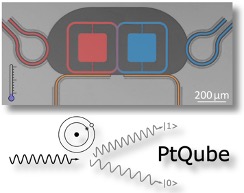
PtQube
- contact:
- funding:
BMBF
- Partner:
PHI-KIT, Zentrum für adaptive Kryotechnik und Sensorik, TransMIT GmbH, Entropy
- startdate:
2020
- enddate:
2022
The goal of the Platform for Low Temperature Qubit Experiments (PtQube project) is to provide an easy to use platform for experiments with superconducting qubits. It includes a low-maintenance cryostat as well as integrated control and readout electronics.
Project description
The technical basis for the development of quantum physical applications
Research into new quantum technologies is currently experiencing a considerable upswing worldwide. This is supported above all by expectations of the performance of quantum computers. However, other quantum technologies also promise considerable progress in the fields of measurement technology, sensor technology, medical technology or biotechnology.
However, the most promising applications of quantum technologies cannot be practically implemented in the short term. The necessary instrumentation is lacking for this purpose, and much of it has yet to be developed. The quantum phenomena used react very sensitively to external influences and are therefore very short-lived. The provision and control of these phenomena requires a considerable amount of equipment. Even where basic functions have already been demonstrated, the technical mastery of quantum systems is still far too expensive and not robust enough for practical use. It is therefore necessary to develop new devices for use in quantum technologies in close cooperation between the manufacturers of the technical equipment and the researchers in the laboratories. Stable and cost-effective systems should significantly improve the prospects for successful commercial exploitation of quantum effects. A major objective of the funded projects is to help local companies to establish themselves as world-leading suppliers of equipment for research and development.
Experimental platform for simple quantum computing functions
The aim of the project is to create a novel experimental platform that is attractive to potential users for those quantum computing applications that require very low temperatures near absolute zero for their function. This is currently the case for almost all of the most advanced quantum computers, as they consist of superconducting circuits.
The platform should be easy to use, low-maintenance and at the same time cost-effective, and should allow interested parties from industry and research institutes to familiarize themselves with the simple functions of a quantum circuit without having to incur the considerable costs that are currently required to operate such highly sensitive superconducting quantum systems. This is to be achieved by operating them largely without the
otherwise necessary for such low temperatures, and in particular without the need for cryogenic liquids that are difficult to handle, such as liquid helium.
Access to user-friendly experimental platforms is a key element that allows computer scientists and engineers to familiarise themselves with the characteristics of a quantum computer at an early stage and to develop a practical environment of software and hardware interfaces even before practical, fully functional quantum computers are available and without the currently enormous costs of producing and operating large quantum circuits of several tens of qubits.
Easy handling through innovative cooling technology and flexible control electronics
The project aims to combine existing know-how in Germany in the field of superconducting qubits with technologies in the field of electronics and cryogenics. The enormous progress in the development of artificial two-level quantum systems (qubits) based on superconducting circuits has led to an increase of their lifetime over several orders of magnitude in the last two decades, thus opening up a feasible way to use this technology for qubit algorithms. The outstanding qualities, apart from the long lifetime, are the great potential in the scalability of individual qubits and the comparatively simple production. These latest generation qubits are to be operated with modern cryotechnology that can be automated as far as possible and is completely free of cryogenic liquids. In addition, a newly developed qubit control readout electronics based on highly integrated field programmable gate arrays (FPGA) allows enormous cost savings compared to conventional techniques. At the same time, the functionally higher integration density compared to classical laboratory setups also opens up new possibilities for implementing more complex qubit circuits and algorithms.
With the long-term goal of an easy-to-use superconducting or semiconducting quantum computer, the platform to be developed will make it possible to provide the user with an abstract qubit architecture in the long term, on which he can execute his qubit algorithms with little or no knowledge of the hardware used.
Our contribution
Within this project we develop the FPGA based control and readout electronics, which should allow an easy control of qubits. The core of the technology is a so-called RFSoC device, which contains a processor system, FPGA logic and fast analog-to-digital and digital-to-analog converters. This allows us to pursue a highly integrated approach, where the essential components of the signal processing chain are located within this device. In addition, a highly integrated mixing electronics is to be created, which will enable up- and downshuffling from the baseband to the actual frequency range of the qubit. The high level of integration promises a high quality of the electronics with simultaneous cost savings compared to standard measurement equipment.

